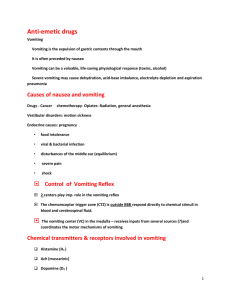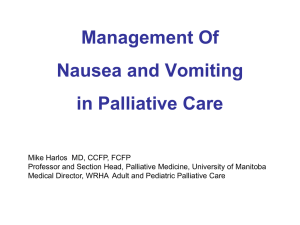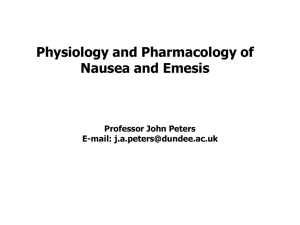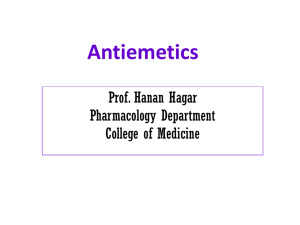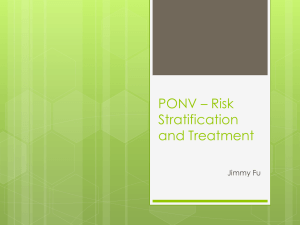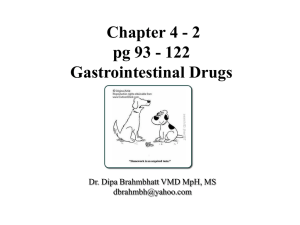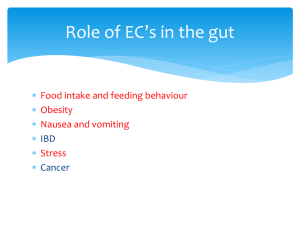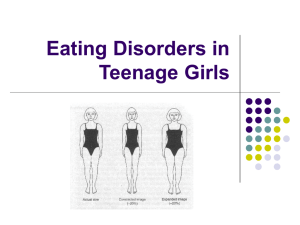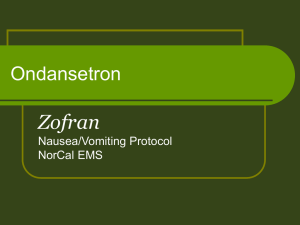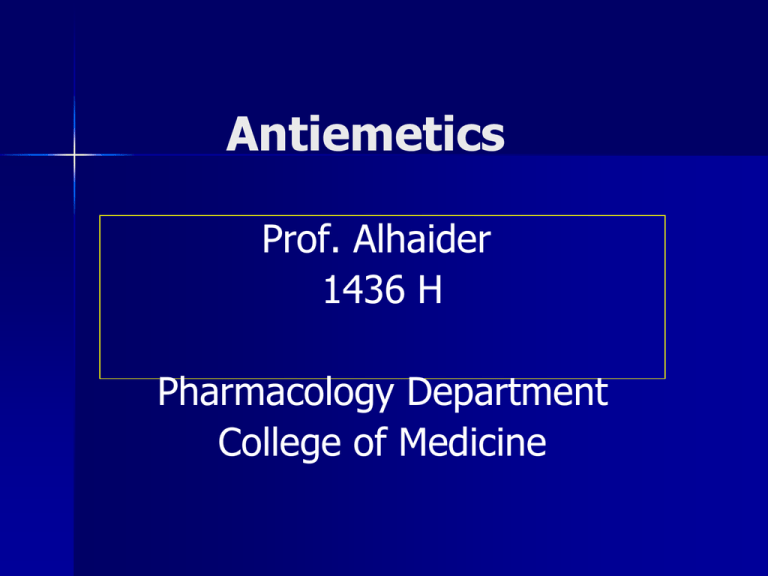
Antiemetics
Prof. Alhaider
1436 H
Pharmacology Department
College of Medicine
Learning objectives
Classify the main different classes of antiemetic
drugs according to their mechanism of action.
Know the characteristic pharmacokinetics &
dynamics of different classes of antiemetic
drugs.
Identify the selective drugs that can be used
according to the cause of vomiting.
Learn the adjuvant antiemetics.
Describe the major side effects for the different
classes of antiemetics.
Vomiting
Is a complex series of integrated events
culminating in the forceful expulsion of
gastric contents through the mouth.
Such events are coordinated by the emetic
(vomiting) center (VC), lying in reticular formation
in medulla.
Vomiting can be a valuable, life-saving physiological response ‼‼ to rid stomach & intestine of
toxins & prevent their further ingestion
Consequences of vomiting
Severe vomiting may result in :
Dehydration
Acid-base imbalance
Electrolyte depletion
Aspiration, pneumonia
Causes of Nausea and Vomiting
Nausea and vomiting may be manifestations of
many conditions . However, a useful
abbreviation for remembering causes of nausea
and vomiting is VOMIT.
Vestibular
Obstruction or drugs like opiates)
Mind (dysmotility)
Infection (irritation of gut)
Toxins (taste and other senses)
Causes of Vomiting
As from previous slide nausea and vomiting
may be manifestations of many conditions and
may occur due to stimulation of vomiting
center that respond to inputs from:
Chemoreceptor trigger zone (CTZ) stimulation
Disturbance of vestibular system
Higher cortical centers stimulation (CNS)
The periphery via sensory nerves
1. CTZ
stimulation
CTZ is an area of medulla that communicate with
vomiting center to initiate vomiting.
CTZ is physiologically outside BBB
CTZ Contains D2 & 5 HT3 receptors.
CTZ can be stimulated by
Drugs such as morphine, apomorphine, L-dopa,
bromocryptine, digitalis, estrogen, emetine.
Chemicals
Radiation.
Uremia.
2. The periphery via sensory nerves
GIT irritation, myocardial infarction, renal or
biliay stones.
3. Disturbance of vestibular system
4. Higher cortical centers stimulation:
emotional factors, nauseating smells or sights.
Receptors Associated with Nausea and Vomiting
Pathophysiology of Emesis
Cancer chemotherapy
Opioids
Chemoreceptor
Trigger Zone
(CTZ)
(Outside BBB)
Dopamine D2
5 HT3,,Opioid
Receptors
Cerebral cortex
Smell
Sight
Thought
Anticipatory emesis
Vomiting Centre
(medulla)
Muscarinic, 5 HT3 &
Histaminic H1
Motion
sickness
Chemo & radio therapy
Gastroenteritis
Pharynx & GIT
5 HT3 receptors
Vestibular
nuclei
Muscarinic
Histaminic H1
What are neurotransmitters & receptors
involved in vomiting include?
Histamine (Histaminergic receptors H 1)
Serotonin (5 -HT3)
Ach (Muscarinic)
Dopamine (D2)
Substance P (Neurokinin receptors)
Opioid Receptors
Classification of Antiemetic Drugs:
Which group of drugs can be used as
antiemetics?
1.
2.
3.
4.
5.
6.
7.
5-HT3 antagonists
D2 receptor antagonists
NK1 antagonists
H1-receptor antagonists
Muscarinic receptor antagonists
Cannabinoids
Glucocorticoids
General rules on use of antiemetics
Should only be used when the cause of nausea or vomiting is known
i.e cause of vomiting should be diagnosed.
Otherwise, the symptomatic relief produced could delay diagnosis of
a remediable and serious cause.
Treat the cause (e.g. diabetic ketoacidosis, intestinal obstruction,
intracerebral space-occupying lesion) usually cures the vomiting.
The choice of drug depends on the aetiology
Indications of antiemetics
1- Chemotherapy-induced
vomiting
2- Post-irradiation vomiting
3- Postoperative vomiting
4- Vomiting of pregnancy
5- Motion (travel) sickness
Antiemetics
5-HT3 antagonists
e.g. Ondansetron, Granisetron
The most Potent antiemetic, mediated through
central (vomiting center, chemoreceptor trigger
zone) and peripheral (intestinal and spinal)
act by 5-HT3 receptor blockade
Orally or i.v., long duration of action.
Has high first pass metabolism
Very effective in nausea & vomiting due to :
– Cytotoxic drugs (cisplatin)
– Post-radiation and Post-operative (second
line).
Side effects of 5-HT3
antagonists
Well tolerated
Headache, dizziness and
constipation
minor ECG abnormalities (QT
prolongation)
D2 receptor antagonists
o
Antagonize D2 receptors in CTZ
o
Drugs such as Metoclopramide PlasilR,
Domperidone (MotiliumR )
o
Both drugs are also prokinetic agents due to
their 5 HT4 agonist activity
o
Domperidone- oral; Metoclopramide-oral, i.v.
o
Metoclopramide crosses BBB but domperidone
cannot.
o
Effective against vomiting due to drugs,
gastroenteritis, surgery, toxins, uremia,
radiation
o
Can be used in reflux esophagitis .
Note: Metoclopramide also it has 5-HT3
antagonistic activity (First discovered 5HT3 antagonist)
Which is a better antiemetic, metoclopramide or
domperidone ?
As CTZ is outside BBB both have antiemetic
effects.
But as metoclopramide crosses BBB it has
adverse effects like extrapyramidal side
effects.
Side effects dyskinesia , galactorrhea,
menstruation disorders, sedation (only for
metoclopramide).
Recent caution regarding the cardiac side effects
of domperidone
Cardiac arrest as a result of QT prolongation occurred
with very few patients taking domperidone. Therefore:
1) Dose of domperidone should not exceed
30 mg/day
2) only used for Nausea and vomiting and
should not be used as prokinetic
3) should not be given for patients with
cardiac conductivity problems
4) lastly, should also not to be used for long
time.
Other uses of Metoclopramide
Facilitate duodenal intubation & endoscopy
Regurgitation & reflux oesophagitis
Diagnostic radiology of gut time required for
barium to reach caecum No. of films required
Clears gastric contents in emergency anaesthesia
Gastroenteritis (the most common use)
Other D2 receptor antagonists
Neuroleptics:
Antipsychotics with potent antiemetic
property due to D2 antagonism
Chlorpromazine, Droperidol
orally, parentrally, suppository
used for vomiting due to chemotherapyinduced emesis
Side effects: extrapyramidal symptoms
hypotension, sedation, restlessness
Neurokinin1 (NK1) receptor antagonists
Aprepitant
Is a substance P antagonists that acts by
blocking neurokinin 1 receptors.
Used in prevention of acute and delayed
chemotherapy-induced nausea and vomiting
(CINV) and for prevention of postoperative
nausea and vomiting (Third line).
H1-receptor antagonists
Effective for motion sickness, morning
sickness in pregnancy, Vestibular
Disturbances and to combat opioid nausea.
Drugs as
– Diphenhydramine
– Cyclizine
– Meclizine
– Promethazine: severe morning sickness of
pregnancy (if only essential).
Not in chemotherapy-induced vomiting.
Muscarinic receptor antagonists
Hyoscine (scopolamine)
Used as trans-dermal patches in motion sickness
(applied behind the external ear).
Not in chemotherapy-induced vomiting
Cannabinoids
Nabilone, dronabinol (psychoactive drugs)
Used as adjuvant in chemotherapy induced
vomiting.
Side effects: Sedation, hallucination and
dysphoria.
Glucocorticoids
Dexamethasone and methylprednisolone
Highly effective in acute emesis alone or
combined with ondansetron.
Used for vomiting by cytotoxic drugs.
Side effects:?????????????
–
–
–
–
–
–
–
Hyperglycemia
Hypertension
Cataract
Osteoporosis
Increased intraocular pressure
Increased susceptibility to infection
Increased appetite & obesity
Summary for
Therapeutic Choice of Antiemetics
Motion sickness
Hyoscine: For short Journey.
Diphenhydramine: For Long Journey.
Vomiting with pregnancy (morning sickness)
Avoid all drugs in the first trimester
Pyridoxine (B6)
Promethazine ( late pregnancy).
Drug- induced vomiting (CTZ)
domperidone & metoclopramide
Vomiting due to cytotoxic drugs.
Ondansetron
D2- antagonists.
Dexamethazone
Nabilone .
Post operative vomiting
Dopamine antagonists (Metoclopromide or
Domperidone)
Now a day, selective 5-HT3 antagonists are
commonly used
Thank you
Questions ?
aqahaider@hotmail.com

